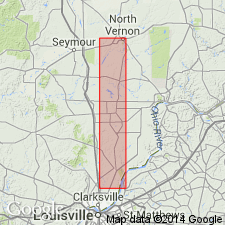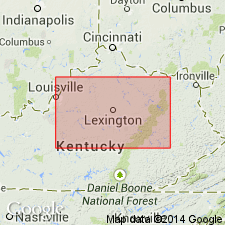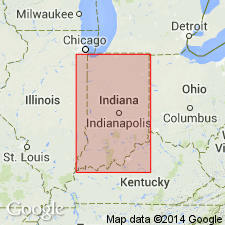
- Usage in publication:
-
- Camp Run Member
- Modifications:
-
- Named
- Biostratigraphic dating
- Dominant lithology:
-
- Shale
- Mudstone
- AAPG geologic province:
-
- Cincinnati arch
Summary:
Named as a member of New Albany Shale. Named for Camp Run, a creek just northeast of type section, Clark Co., southeastern IN. Consists of greenish-gray to olive-gray mudstone and shale interbedded with brownish-black, carbon-rich, fissile, pyritic shale. Contains some dolomitic concretions up to 3 ft in diameter near top of section. Thickness ranges from 14 to 18 ft in outcrop area. Unit cannot be differentiated in subsurface. Overlain by Clegg Creek Member; underlain by Morgan Trail Member. Correlates with Antrim Shale and possibly part of Ellsworth Shale in Michigan basin, as well as with part of Grassy Creek Shale. Report contains measured section and chart. Age is Late Devonian based on POLYOPHODONTA CONCENTRICA, PALMATOLEPIS GLABRA, and P. PERLOBATA. Also contains carbonized plant remains, silicified CALLIXYLON, LINGULA, and a few small pyritized gastropods and pelecypods.
Source: GNU records (USGS DDS-6; Reston GNULEX).

- Usage in publication:
-
- Camp Run Member
- Modifications:
-
- Overview
- AAPG geologic province:
-
- Illinois basin
Summary:
Authors follow de Witt (1981) in restricting the New Albany Shale to the Illinois basin and the Ohio Shale to the Appalachian basin. Ohio Shale terminology used wherever Three Lick Bed is recognizable in cores. Unlike de Witt (1981), authors do not use Chattanooga Shale in Knobs outcrop area of south-central KY. Most of New Albany correlates with the Huron Member of Ohio Shale. Upper 1 to 2 m correlates with Cleveland Member. New Albany subdivided into (ascending) Blocher, Morgan Trail, Camp Run, and Clegg Creek Members.
Source: GNU records (USGS DDS-6; Reston GNULEX).

- Usage in publication:
-
- Camp Run Member
- Modifications:
-
- Overview
- AAPG geologic province:
-
- Illinois basin
Summary:
In the outcrop area of the New Albany Shale of southeastern IN, the Morgan Trail, Camp Run, and Clegg Creek Members are differentiated above the Selmier Member. They are also recognized in the subsurface of west-central KY. Together the three members reach a thickness of 140 ft in Posey and Vanderburgh Cos, IN, but thin to 60 ft in central and northern IN. They are mapped as undifferentiated in southwestern IN. Thickness of the Camp Run is fairly uniform throughout the subsurface in southeastern IN, where it ranges from 24 to 28 ft.
Source: GNU records (USGS DDS-6; Reston GNULEX).

- Usage in publication:
-
- Camp Run Member*
- Modifications:
-
- Biostratigraphic dating
- AAPG geologic province:
-
- Illinois basin
- Cincinnati arch
Summary:
Conodont biostratigraphy indicates that the Camp Run Member of the New Albany Shale is of Late Devonian (Famennian) age. Conodonts from the CREPIDA, RHOMBOIDEA, and MARGINIFERA Zones were recovered. Unit overlies the Morgan Trail Member and underlies the Clegg Creek Member, both of the New Albany Shale.
Source: GNU records (USGS DDS-6; Reston GNULEX).
For more information, please contact Nancy Stamm, Geologic Names Committee Secretary.
Asterisk (*) indicates published by U.S. Geological Survey authors.
"No current usage" (†) implies that a name has been abandoned or has fallen into disuse. Former usage and, if known, replacement name given in parentheses ( ).
Slash (/) indicates name conflicts with nomenclatural guidelines (CSN, 1933; ACSN, 1961, 1970; NACSN, 1983, 2005, 2021). May be explained within brackets ([ ]).

